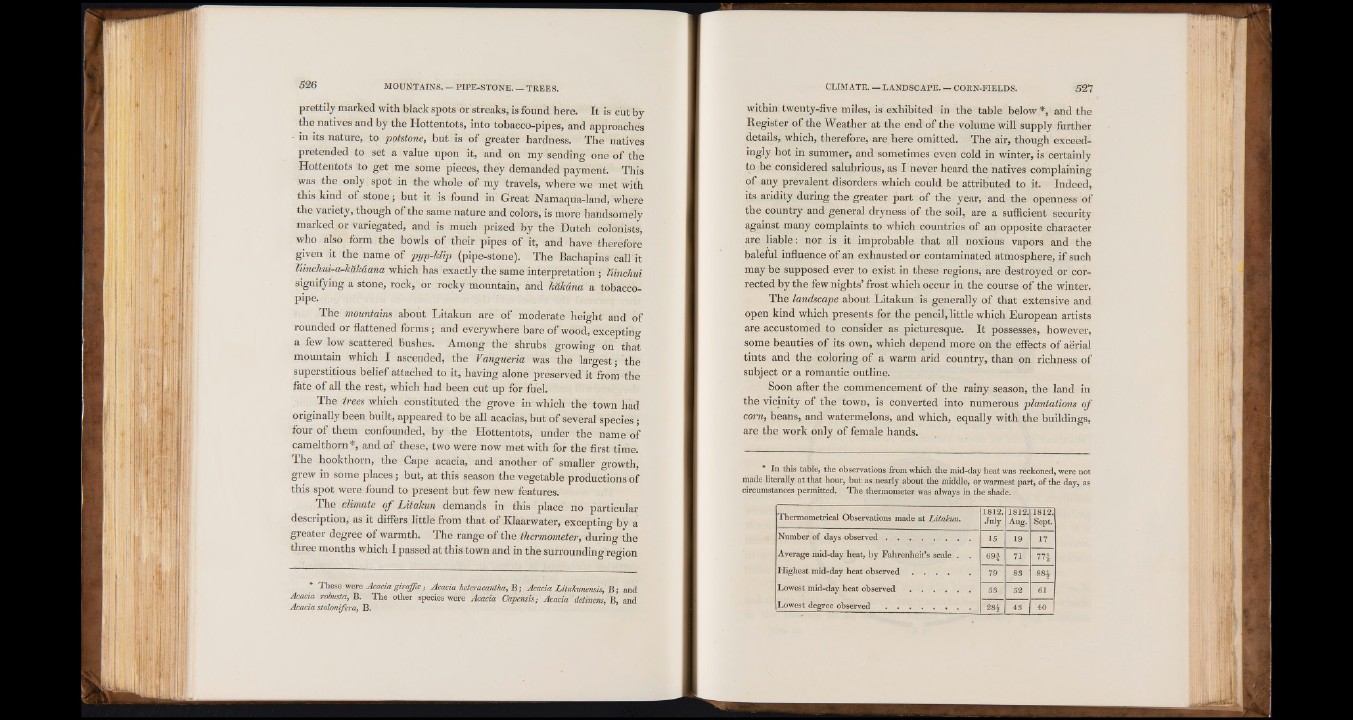
prettily marked with black spots or streaks, is found here. It is cut by
the natives and by the Hottentots, into tobacco-pipes, and approaches
■ in its nature, to potstone, but is of greater hardness. The natives
pretended to set a value upon it, and on my sending one of the
Hottentots to get me some pieces, they demanded payment. This
was the only spot in the whole of my travels, where we met with
this kind of stone; but it is found in Great Namaqua-land, where
the variety, though of the same nature and colors, is more handsomely
marked or variegated, and is much prized by the Dutch colonists,
who also form the bowls of their pipes of it, and have therefore
given it the name of pyp-klip (pipe-stone). The Bachapins call it
It in eh u i- (i-kdka an a which has exactly the same interpretation ; lunchui
signifying a stone, rock,; or rocky mountain, and Icdkdna a tobacco-
pipe.
The mountains about Litakun are of moderate height and of
rounded or flattened forms ; and everywhere bare of wood, excepting
a few low scattered bushes. Among the shrubs growing on that
mountain which I ascended, the Vangueria was the largest; the
superstitious belief attached to it, having alone preserved it from the
fate of all the rest, which had been cut up for fuel.
The trees which constituted the grove in which the town had
originally been built, appeared to be all acacias, but of several species;
four of them confounded, by the Hottentots, under the name of
camelthorn*, and of these, two were now met with for the first time.
The hookthorn, the Cape acacia, and another of smaller growth,
grew in some places; but, at this season the vegetable productions of
this spot were found to present but few new features.
The climate of Litakun demands in this place no particular
description, as it differs little from that of Klaarwater, excepting by a
greater degree of warmth. The range of the thermometer, during the
three months which I passed at this town and in the surrounding region
* These were Acacia gira ffa , Acacia heteracantha, B ; Acacia Litakunensis, B; and
Acacia robusta, B. The other species were Acacia Capensis; Acacia detinens, B, and
Acacia stolonifera, B.
within twenty-five miles, is exhibited in the table below *, and the
Register of the Weather at the end of the volume will supply further
details, which, therefore, are here omitted. The air, though exceeding1}
7 hot in summer, and sometimes even cold in winter, is certainly
to be considered salubrious, as I never heard the natives complaining
of any prevalent disorders which could be attributed to it. Indeed,
its aridity during the greater part of the year, and the openness of
the country and general dryness of the soil, are a sufficient security
against many complaints to which countries of an opposite character
are liable: nor is it improbable that all noxious vapors and the
baleful influence of an exhausted or contaminated atmosphere, if such
may be supposed ever to exist in these regions, are destroyed or corrected
by the few nights’ frost which occur in the course of the winter.
The landscape about Litakun is generally of that extensive and
open kind which presents for the pencil, little which European artists
are accustomed to consider as picturesque. It possesses, however,
some beauties of its own, which depend more on the effects of aerial
tints and the coloring of a warm arid country, than on richness of
subject or a romantic outline.
Soon after the commencement of the rainy season, the land in
the vicinity of the town, is converted into numerous plantations of
com, beans, and watermelons, and which, equally with the buildings,
are the work only of female hands.
* In this table, the observation^ from which the mid-day heat was reckoned, were not
made literally at that hour, but as nearly about the middle, or wannest part, of the day, as
circumstances permitted. The thermometer was always in the shade.
Thermometrical Observations made at Litakun. 1812.
July
1812.
Aug.
1812.
Sept.
Number of days observed .........................................
Average mid-day heat, by Fahrenheit’s scale . .
Highest mid-day heat o b se r v e d ............................
Lowest mid-day heat o b s e r v e d .............................
Lowest degree observed . . . . . . .
15 19 17
69f 71 771
79 83 88£
53 52 61
28i 43 40